Hot dog history – different type of hot dog
A hot dog is a fast food superstar. This go-to choice for barbecues and ballparks has become an institution of American and global culinary culture. From its humble European origins to a dazzling American variety, this sausage-in-a-bun has been around for a long time. Do you enjoy yours piled high with toppings, or do you prefer to keep it simple with just mustard? Have you ever wondered who created it? Or the best way to eat it? And which variety makes everyone’s taste buds stand up and cheer?
This culinary delight has become one of the most recognizable food symbols of America and has spread rapidly across the world, becoming a global eating phenomenon. In this hot dog guide, we’ll embark on a brief historical journey to uncover its original creators, cover the different types of hot dogs around the world, discuss the dos and don’ts of hot dog etiquette, and provide simple step-by-step recipes to recreate this centuries-old culinary tradition in your kitchen.
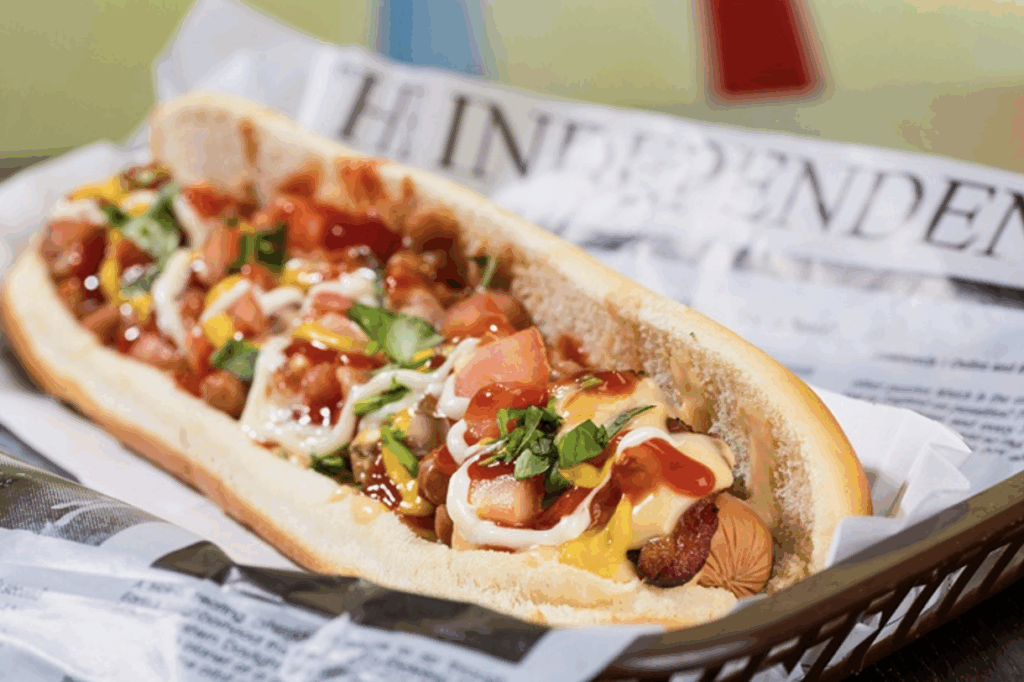
Hot Dog Origins: Main Contenders
Hot dogs have been around for a long time — way longer than you think. The sausage, the hot dog’s core ingredient, ranks among the oldest forms of processed food, even appearing in Homer’s Odyssey. Hot dog origins go all the way back to Germany, where sausages were already a staple before they crossed the Atlantic. The story has two main contenders: frankfurters from Frankfurt and wieners from Vienna — the latter claims that the word ‘wiener’ is the living proof of the hot dog’s origin, while the former marked the hot dog’s 500th anniversary in the city of Frankfurt. By the 1800s, German immigrants brought their sausage-making expertise to America. One report claims a German immigrant sold dachshund sausages in rolls with sauerkraut and milk bread from a pushcart in New York City’s Bowery. In 1871, Charles Feltman, a German-American baker, began selling frankfurters in rolls at Coney Island, New York, selling over 3,600 in the first year of operation — igniting America’s love for hot dogs.
The origin of the term “hot dog” is disputed but often credited to New York Journal sports cartoonist Tad Dorgan, who drew a dachshund-shaped sausage in a bun in 1901. The catch? That cartoon has never been found. Another theory suggests that it stems from German immigrants’ dachshund dogs. According to hot dog historian and professor at Roosevelt University in Illinois, Bruce Kraig, the “hot dog” is most likely a name referring to the Germans’ long and thin dogs.
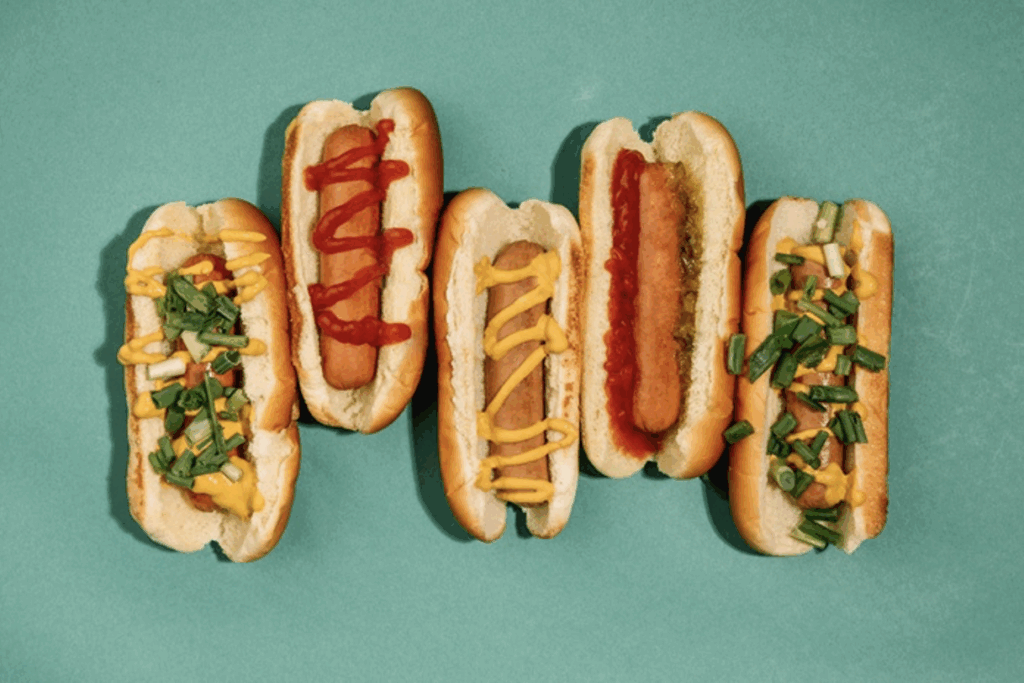
Exploring Main Varieties: So Many Hot Dogs, So Little Time
Let’s explore the mainhot dog types because there’s a lot to cover. Have you ever wondered what are the big hot dogs called? The giant ones, like foot-longs, jumbo franks, or big boys, are at the peak of their hot dog game. Made predominantly from pork or beef, they should be your go-to when you’re starving. By contrast, multiple standard varieties work perfectly as a quick snack. In short, there are different types of hot dogs for any occasion. Below is a rundown of the main names of hot dogs, their distinctive features, and quick preparation tips. With the right ingredients and basic cooking skills, you can recreate these classics in your kitchen.
1. New York Style Hot Dog
When visiting New York, trying the local hot dog is an absolute must. This street food is iconic — it often appears in many Hollywood movies set in the Big Apple, where two characters discuss everything, from work to dating life, while munching on the famed New York-style hot dog. The recipe is no secret: a boiled beef frankfurter, a soft bun, and a generous helping of sauerkraut, spicy brown mustard, and onion sauce. The final topping stands out. Made from tomato paste, spices, and sautéed onions, it boasts a distinctive sweet and slightly savory taste that perfectly contrasts the zesty taste of brown mustard. This simple yet juicy creation is served in a paper tray or wrapped in foil and is best enjoyed on the go.
Although there is no one founder who created the New York variety, the credit typically goes to German migrants like Charles Feltman, who sold over 3,600 hot dogs in his first year of operation, and Nathan Handwerker, founder of Nathan’s Famous, a fast-food chain renowned for its hot dogs.
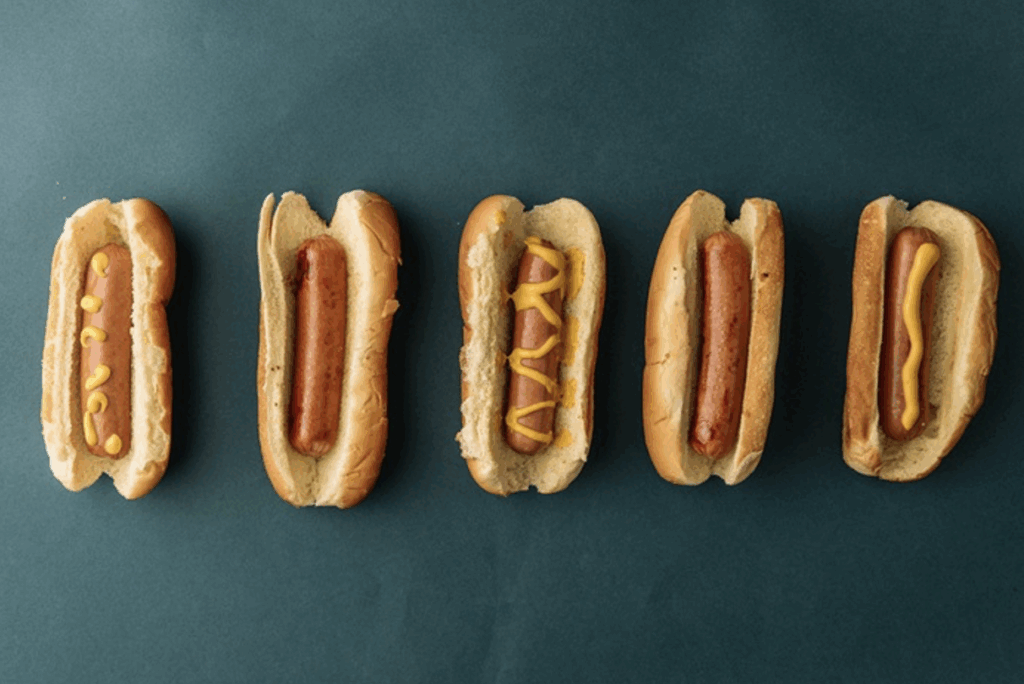
How to Cook a New York-Style Hot Dog
Not a New Yorker but eager to try the local go-to food? Why not make it yourself? The recipe is beginner-friendly and simpler than you may think.
You’ll Need:
- Jumbo beef franks and hot dog buns;
- 1-2 tablespoons of olive oil, ½ cup water, ¼ cup ketchup;
- 2 medium onions;
- Cinnamon, chili powder, cayenne pepper;
- Spicy brown mustard;
- 1 cup sauerkraut.
Quick Guide: A sausage in a bun is not exactly haute cuisine, so how hard is it to prepare one at home? Sauté onions in oil until soft, then add spices — chilli powder, cayenne pepper, and cinnamon — followed by water and ketchup; simmer for around 10 minutes until the onion sauce thickens. Meanwhile, boil the beef franks for around 5 minutes. Once done, put the sausage in the hot dog bun and add the classical New York toppings like spicy brown mustard, sauerkraut, and onion sauce. And voilà!
Verdict: While the boiled beef frankfurter encased in a steamed white bun is delicious on its own, the sweet and tangy combination of sautéed onions, spices, tomato paste (or ketchup), brown mustard, and sauerkraut defines the famed New York-style hot dog.
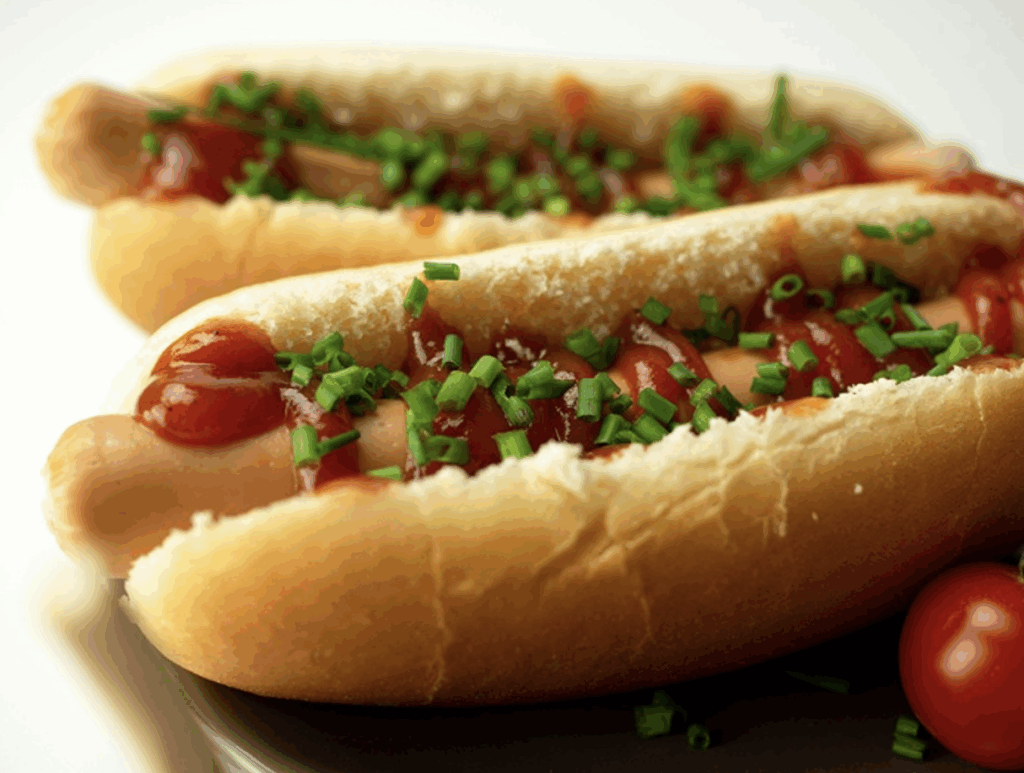
2. Chicago Hot Dog
Often lauded as superior to their New York-style counterparts, Chicago hot dogs are strong contenders for America’s finest. Picture this: an all-beef frankfurter in a signature poppy-seed bun topped with chopped white onion, tomato slices, sweet green pickle relish, a pickle spear, pickled sport peppers, a dash of celery salt, and a healthy dose of yellow mustard. It’s practically a garden on a bun! The Chicago hot dog can be steamed, water-steamed, or grilled over charcoal, providing a more diverse experience to your taste buds. Ketchup is a big no — many vendors don’t even offer it as a condiment.
The history of the Chicago hot dog took root in the Great Depression, when hot dogs topped with multiple ingredients were a healthy all-in-one affordable alternative to other meals. Dubbed the ‘Depression Sandwich,’ it gained traction as Jewish immigrants introduced the all-beef dog — a safer choice to pork sausages from Chicago’s Union Stockyards, notorious for their abysmal hygiene standards. Thus, the signature Chicago hot dog was born, becoming a staple in the Windy City’s culinary scene and one of the most popular hot dogs in America.
How to Cook a Chicago-Style Hot Dog
Preparing the Chicago staple fast food is not much different from cooking the famous New York one. The main difference is that the former requires way more toppings and ingredients, some of which you probably already have in the pantry.
You’ll Need:
- Vienna beef dogs/Red Hot Chicago brand dogs;
- Poppy seed buns;
- Sweet relish, red ripe tomato, pickle cucumber slices, sport peppers, onion;
- Mustard, celery salt (a blend of ground celery seed and fine-grained salt).
Quick Guide: It all starts with a sausage — place it into the boiling water (reduce heat to low) and cook for about 5 minutes. The bun should also be warmed up — you can put it for 2 minutes over a steaming basket. When assembling your own Chicago hot dog, you can’t just stuff in the ingredients haphazardly — the placing is as important as the components. Stuff the sausage into the bun and squirt the mustard in a zig-zag pattern from one end to another. Next, add a generous helping of sweet relish, sprinkle some onions on the top, and place two tomato slices between the sausage and the top of the bun. The pickles go in the opposite direction — stuff them between the sausage and the bottom of the bun. Add two sports peppers on the top and a sprinkle of celery salt. With your masterpiece assembled, all that’s left to do is to dive in.
Verdict: Chicago-style hot dogs are an all-in-one meal that offers a diverse flavor profile that’s sweet, savory, and tangy at the same time. The multiple fresh and pickled ingredients create a complex palette, a must-try for any hot dog enthusiast.
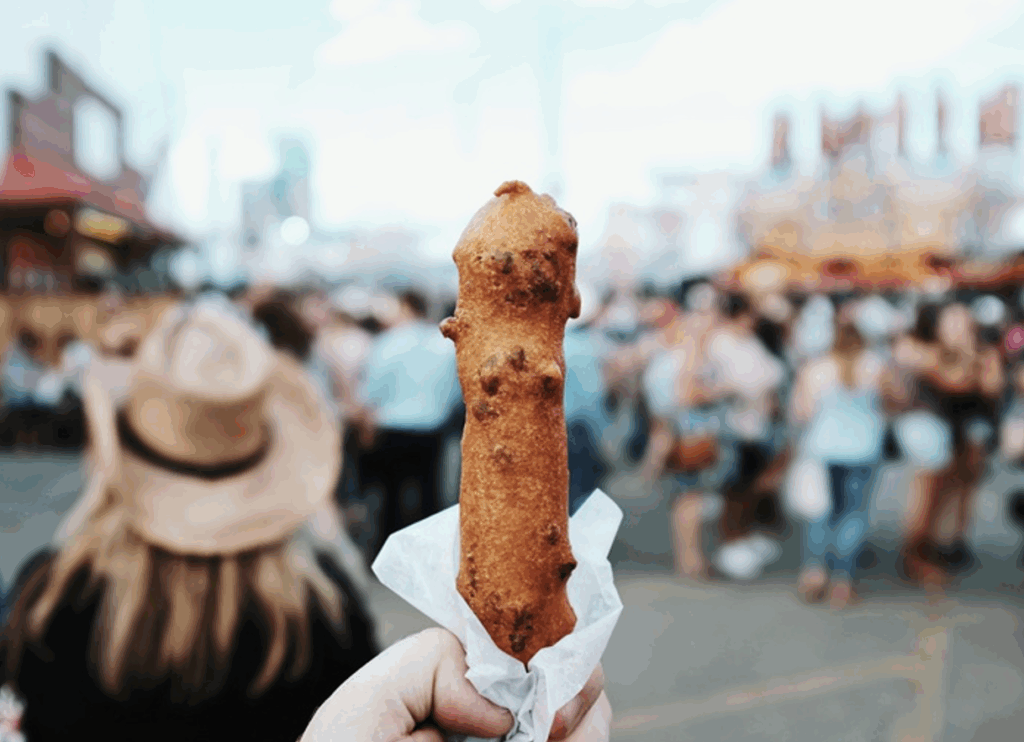
3. Corn Dog
Out of all of the styles mentioned in this guide, corn dogs have the most distinctive look. Impaled on a stick, this all-American classic doesn’t have a traditional bun encasing a sausage; instead, the sausage is coated in a thick layer of batter and then deep-fried to juicy, golden perfection. The batter differs but typically includes flour, cornmeal, baking powder, sugar, and some seasonings for extra spice. Of course, gathering the ingredients, preparing the batter, and deep-frying the corn dog are time-consuming. Premade frozen corn dogs present a shortcut, allowing quick thawing and then frying or heating them in the microwave. Once the crust reaches your desired level of crispiness, add condiments—you can drizzle anything from ketchup or mustard to honey; the latter creates a sweet contrast to the juicy, meaty interior.
While many entrepreneurs lay claim to the creation and popularization of corn dogs, in reality, it’s a collaboration of multiple entrepreneurs. Notable figures include Carl and Neil Fletcher, who have introduced their trademark corny dogs at the State Fair of Texas, and Ed Waldmire, the co-founder of Cozy Dog Drive-In, who boasted of perfecting the ultimate corn dog recipe. Today, corn dogs are an integral part of American street food culture and a go-to choice at fairs and carnivals.
How to Cook a Corn Dog
While cooking a corn dog is hardly rocket science, it’s a much more demanding recipe that requires you to know your way around the kitchen, especially considering that you’ll be handling scalding oil.
You’ll Need:
- Sticks for corn dogs;
- Beef and pork blend for hot dogs (you can try chicken or turkey hot dogs, too);
- 1 cup finely ground cornmeal, 1 cup all-purpose flour, 4 tsp baking powder, ¼ tsp salt, ¼ cup sugar, one egg — crucial batter ingredients;
- 1 cup milk;
- Vegetable oil (for frying);
- Honey, mustard, or ketchup.
Quick Guide: Mix the dry ingredients — cornmeal, flour, baking powder, sugar, and salt. Then whisk the wet ones: egg, milk, and a splash of oil. Combine both mixtures and stir until smooth. Next, skewer hot dogs with the sticks and dip them into the batter until the hot dog is completely covered. Fry at 350˚F for a couple of minutes until a golden brown crust forms.
Verdict: A corn dog is a creative gastronomic twist on the classic hot dog. The juicy, meaty center is encased in a crunchy golden exterior, creating one of the most distinctive hot dogs in the world. Popular condiments like honey create a mouth-watering combination of juicy meat and drizzling honey goodness. If you’re serious about your hot dogs, a corn dog is a must-try.
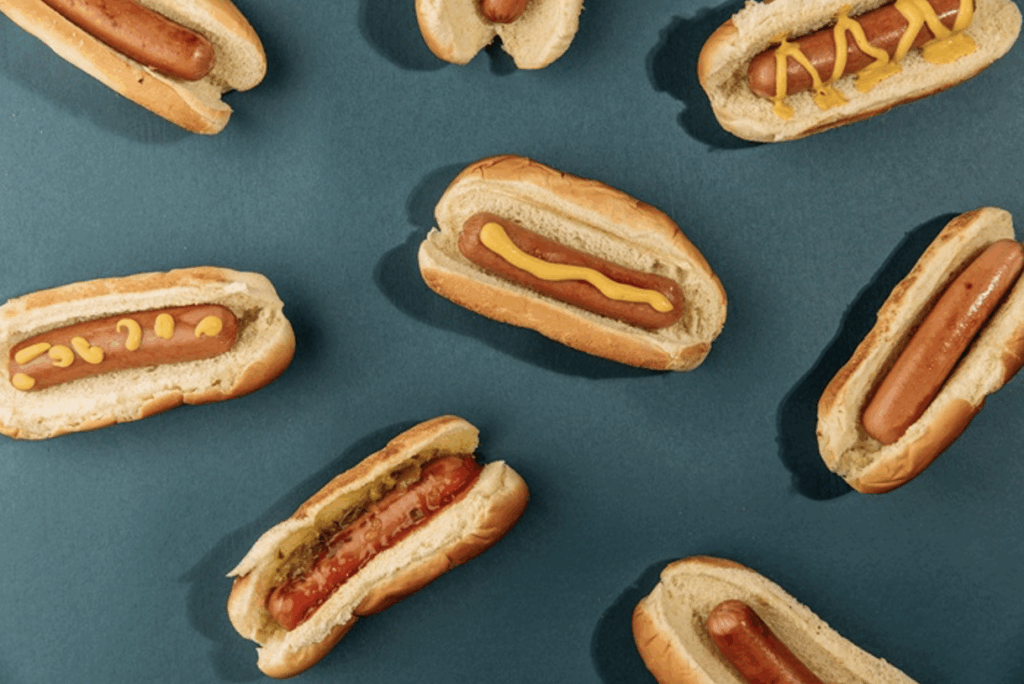
4. Puka Dog
The Hawaiian contribution to the American fast food obsession is the Puka Dog, a tropical twist with a distinctive look — the hot dog is stuffed into a sweet bread bun that has an enclosed bottom and a hole on the top from which the grilled Polish sausage peaks out. The condiments are otherworldly — no boring mustard or ketchup in sight; instead, the customers are treated with passion fruit or mango mustard, spicy garlic citrus sauce, and tropical fruit relish (coconut, pineapple, mango). The mouth-watering combo creates a unique blend of juicy grilled meat, spicy flavors, and tangy tropical condiments.
At the Puka dog stands (‘puka’ means hole in Hawaiian), they use a special heating rod that serves a dual purpose: it pokes the hole in the bun and toasts the insides at the same time. These Hawaiian-style hot dogs originated in Kauai, where Rick and Dominique Quinette created the first-ever Puka Dogs. Dominique, a Swiss immigrant, sold hot dogs as a side gig to support her career; with Puka dogs becoming an overnight success, the couple decided to upgrade from a small foodservice to a permanent store and soon enough, an entire chain of stores.
How to Cook a Puka Dog
Preparing this variety may be challenging for only one reason — you’ll need very specific tropical condiments. Still, you can put your own spin on the Puka, like using a regular bun or replacing some of the ingredients if you can’t find them in the local supermarket.
You’ll Need:
- Hot dog buns;
- Polish sausage;
- Mango or passion fruit mustard;
- Tropical relish (coconut, pineapple, or mango).
Quick Guide: Prepare the buns by poking a hole in each one (you can use a turkey baster). Meanwhile, grill the Polish sausages over high heat for about 5 minutes. Drizzle mango or passion fruit mustard and tropical relish into the buns and stuff the hot dog inside.
If you’re feeling extra ambitious, you can make the toppings yourself. Mango mustard is relatively easy to whip up: blend regular mustard, mango, mayo, garlic, and chile pepper in a food processor and refrigerate for a couple of hours. Making a relish is also straightforward: chop the pineapple and onions, add honey, lime juice, vinegar, and a pinch of salt, then simmer in a saucepan. Cook for 15 minutes until the pineapple has softened.
Verdict: The sweet and savory tropical toppings pair well with the juicy sausage, creating an incredibly distinctive flavor profile. It’s a classic American dish with a tropical twist and an exotic treat to your taste buds.
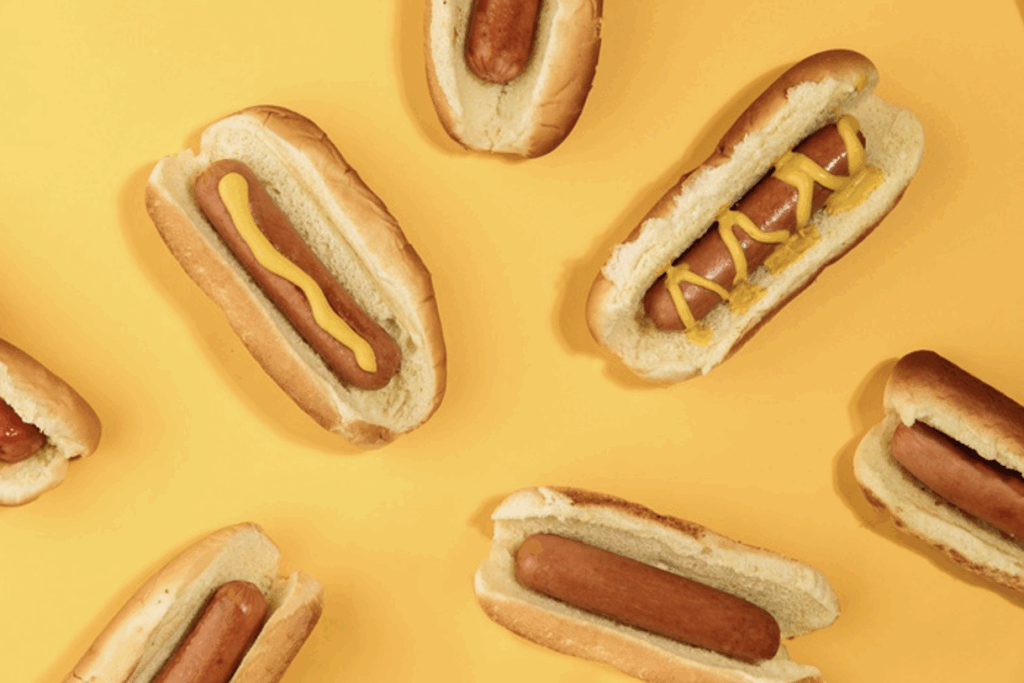
5. Coney Island Hot Dog
The Coney Island hot dog is yet another classic take on the American staple. Unlike some of the previous recipes, Coney Island is straightforward, no-nonsense food that consists of juicy beef frankfurter, steamed bun, Coney sauce (meat chili sauce made of seasoned ground beef), raw onions, yellow mustard, and sometimes even cheese. The vendors, who feel like experimenting, spice the Coney with other toppings, like jalapenos, cheddar, and pickles.
Despite its name, the Coney Island-style hot dog emerged simultaneously among Greek and other immigrants in Ohio, Michigan, New York, and other states nationwide. These parallel developments culminated in the classic hot dog with a staple chili meat sauce.
How to Cook a Coney Island Hot Dog
While assembling the hot dog is a breeze, preparation of the Coney meat sauce is the bulk of the work that will take you around an hour. If you love your fast food extra meaty, this hearty hot dog variation is a must-try.
You’ll Need:
- For the sauce: 1 pound of ground beef; water; ½ cup diced onions, ⅓ cup ketchup, 2 tbs butter, 2 cloves of garlic, 2 tbs of chilli powder, spices (black pepper, cumin, celery salt, cayenne pepper);
- Beef sausages;
- Buns;
- Mustard.
Quick Guide: First, the sauce. To prepare the classic Coney sauce, combine all the ingredients — ground beef, onion, butter, garlic, chili powder, ketchup, and spices — in a skillet and mix with a spatula. Once the sauce starts bubbling, leave it on low heat for one hour, occasionally stirring. As the sauce thickens, season with salt and pepper to taste. It’s pretty simple to make, although it’s crucial to get the proportions right so that the sauce is not too thick or too runny.
Meanwhile, boil the beef frankfurters for about 7 minutes and warm the buns in the oven. It’s time to assemble your own personal Coney Island hot dog! Put the sausage in the bun, add the meat sauce on top, drizzle with mustard to taste, and sprinkle lightly with the remaining diced onions. That’s it!
Verdict: Coney Island-style hot dog is a must for meat lovers: the beef frankfurter and the savory meat chili sauce create an unforgettable, flavourful, and nutritious variant.

6. Dodger Dog
Another iconic American hot dog, the Dodger Dog, honors the Los Angeles Dodgers baseball team. In 2011, the Dodgers Stadium in Los Angeles managed to sell 2 million hot dogs, an astounding number that has established this hot dog variety as one of the most popular in the world. What makes them so special? First, their size: while a standard hot dog is around 6 inches, Dodger Dogs stretch to 10 inches, which makes them the biggest hot dogs on the market. As for varieties, Dodger Dog comes in several forms: the Super Dodger Dog has a 100% beef sausage, while the Doyer Dog swaps the traditional toppings for jalapenos, salsa, and chili. Other twists include the Veggie Dodger Dog (a vegan-friendly option), the Italian Dodger Dog (combines shredded mozzarella and marinara sauce), and the Southwest Dodger Dog (drizzle of sour cream, avocado slices, pico de gallo), among others.
How to Cook a Dodger Dog
You don’t have to be a baseball fan to appreciate the Dodger Dog. While cooking at home, you can customize your recipe until it feels just right. But first, let’s take a quick look at the recipe of the classic Dodger Dog in all its timeless glory. Its simplicity is a part of the appeal — after all, it’s designed to feed the entire stadium full of hungry basketball fans fast.
You’ll Need:
- 10-inch beef hot dog;
- Hot dog buns;
- Ketchup, mayo, yellow mustard;
- Sweet pickle relish, chopped onions.
Quick Guide: Place the sausage on a pan (preferably, grill) — for extra crispness, make shallow slits along the sausage — and rotate frequently for about 10 minutes. As the sausages crisp up, toast the buns for 1-2 minutes to heat them up. Prep done — time to assemble your Dodger Dog! Start with mayo, spread it thinly on the inside of each bun, then place the grilled sausage in the center. Drizzle mustard and ketchup to taste, add a dollop of sweet relish, and top with sprinkling onions.
Verdict: This iconic 10-inch hot dog is easy to make and a joy to eat. No wonder basketball fans snap them up by millions — this grilled, mouth-watering delight is pure perfection.

Hot Dog Etiquette: Biggest Dos and Don’ts
Despite the hot dog’s unpretentious nature (you can eat them however you want to), there are still a few guidelines that will transform a quick snack into a culinary treat. If you want your taste buds to throw a standing ovation and cheer for an encore, follow these suggestions from the National Hot Dog Sausage Council.
Dos
The big ‘yes’ of the hot dog etiquette that will show that you’re not some newbie who doesn’t know his Coney Dog from the Chicago-style hotdog is:
- Eat With Hands. Hot dogs are a simple delight — just grab the bun and dive in! Using utensils might not just raise eyebrows — it will get you banned from the hot dog aficionado club for life. So, hide your utensils, wash your hands, and dig in.
- Serve on Paper Plates. The hot dogs should be served on paper plates, although basic dishes work, too. Bringing your best china — if you even have one — is a big no.
- Simple Buns. The secret of a perfect bun lies in sesame seeds or poppy seeds; plain buns are typically a safe choice. The rule of thumb: don’t overdo it — bringing the entire experience to the next level with some sun-dried tomatoes and gourmet buns is considered a bad tone.
- Lick the Condiments. If you prefer your hot dogs overflowing with toppings, chances are, some of it will land on your fingers. The hot dog etiquette dictates that any condiment that ends up on your fingers shall be licked off — washing it away is strictly prohibited and frowned upon. Seems like you have no choice!
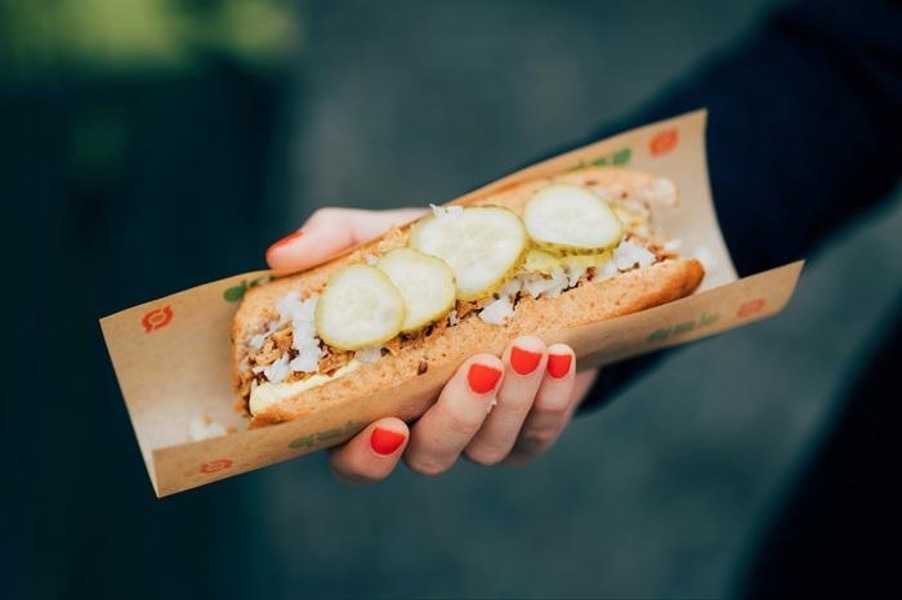
Don’ts
To spare you from public shame and the dreaded “Are you seriously eating it like that?” here’s a list of hot dog etiquette crimes you should never commit:
- Use Ketchup. Listen, when it comes to toppings, the world is your condiment bar — chili, cheese, onions, mustard? All are solid choices. But if you really must drown your hot dog in ketchup, do yourself a favour: do it when you’re home alone. Preferably with the curtains closed. Maybe even under a blanket.
- Bring Wine. The hot dog barbecue is a celebration of simple foods. Iced tea, beer, and soda — all go well together with hot dogs. Attempting to impress the guests with some 2018 Château de Gueulasse is better saved for a more refined occasion.
- Use Cloth. When done with your hot dog, use a paper napkin to wipe your mouth; cloth napkins are considered too bougie.
- Dress the Bun. It’s a simple thing to remember: when adding toppings, start with wet condiments, then progress to clunky ones (like onions), and finish off with cheese and spices. In no circumstance dress a bun.
- Nibble It. You must eat a hot dog assertively: it shouldn’t take you more than five bites to eat a smallish hot dog, and no more than seven to finish off the bigger one.
- Take Your Time. If you don’t hurry up, you’ll end up with a soggy bun—a criminal offense.
Take these rules as mere suggestions to improve your etiquette. At the end of the day, it’s you who decides how to eat a hot dog. Sure, some people may laugh and point fingers, but fortune favors the bold; who knows, you may even start a new trend.
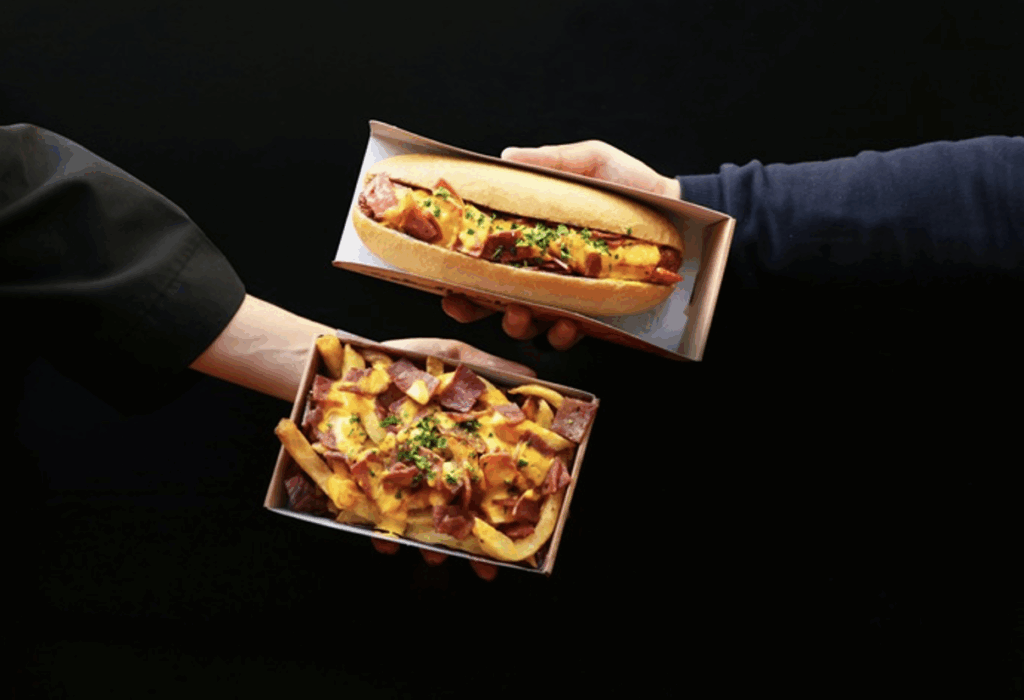
Final Thoughts
Hot dogs are more than just a quick snack: they’re one of the most recognizable culinary symbols of America. Tracing centuries back to Germany, frankfurters and wieners soon transcended their humble origins and became a global phenomenon as German immigrants, with their sausage-making expertise, arrived in America.
Whether you’re at a football game or a low-key barbecue, these fast food superstars are a part of American culinary tradition that has conquered the rest of the world with its delicious and juicy simplicity. For such a simple recipe—essentially, a sausage encased in a bun with some topping to taste — there’s a hot dog for everyone. The tropical flair of the Puka Dog continues to attract crowds of Hawaiians and tourists; the classic meaty sauce of the Coney Island variety is a go-to for any meat lover out there, while, the Dodger Dog, the largest hot dog out there, is a combination of simplicity and smoky, succulent flavor that continues to sell at stadiums packed with basketball fans. So, next time you take a quick bite, take a moment to appreciate the long and delicious hot dog history.








